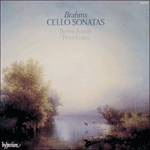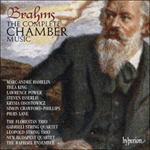
Welcome to Hyperion Records, an independent British classical label devoted to presenting high-quality recordings of music of all styles and from all periods from the twelfth century to the twenty-first.
Hyperion offers both CDs, and downloads in a number of formats. The site is also available in several languages.
Please use the dropdown buttons to set your preferred options, or use the checkbox to accept the defaults.

| Steven Isserlis (cello), Peter Evans (piano)» More |
The first movement, with its glorious sunset coda in E major (Brahms was the master of musical sunsets) is linked to the other two movements chiefly through the dominance of the expressive minor sixth that makes its first appearance in the second bar of the work, and continues throughout the sonata. The second movement, a charming minuet and trio, seems to pay nostalgic tribute to the world of Mozart – or perhaps to that of Schubert, with whose music Brahms was somewhat obsessed at this period. The last movement, a robust mixture of fugue and sonata form, takes its main theme from Contrapunctus 13 from the Art of Fugue – as if Brahms is looking further backwards in time as the sonata progresses.
from notes by Steven Isserlis © 2005
Le premier mouvement, avec sa glorieuse coda crépusculaire en mi majeur (Brahms fut le maître absolu des couchers de soleil musicaux), se rattache aux deux autres mouvements surtout par la prépondérance de l’expressive sixte mineure, qui apparaît pour la première fois à la deuxième mesure et traverse l’œuvre de part en part. Le deuxième mouvement, un charmant menuet et trio, semble rendre un nostalgique hommage à l’univers de Mozart – à moins que ce ne soit à celui de Schubert, dont la musique obsédait alors quelque peu Brahms. Le dernier mouvement, un robuste mélange de fugue et de forme sonate, emprunte son thème principal au Contrapunctus 13 de l’Art de la fugue – comme si Brahms reculait dans le temps à mesure que la sonate, elle, avançait.
extrait des notes rédigées par Steven Isserlis © 2005
Français: Hypérion
Der erste Satz mit seiner großartigen Sonnenuntergangscoda in E-Dur (Brahms war der Meister musikalischer Sonnenuntergänge) ist mit den anderen beiden Sätzen vorwiegend durch die Dominanz der ausdrucksvollen kleinen Sexte verbunden, die erstmals im zweiten Takt des Werks auftaucht und sich die ganze Sonate hindurch fortsetzt. Der zweite Satz, ein charmantes Menuett mit Trio, scheint voller Nostalgie der Welt Mozarts zu huldigen – oder womöglich jener Schuberts, von dessen Musik Brahms zu jener Zeit geradezu besessen war. Der Schlusssatz, eine robuste Mixtur von Fuge und Sonatenform, entnimmt sein Hauptthema dem Contrapunctus 13 aus der Kunst der Fuge – als blicke Brahms im Verlauf der Sonate immer weiter in die Vergangenheit zurück.
aus dem Begleittext von Steven Isserlis © 2005
Deutsch: Anne Steeb/Bernd Müller
 Brahms: Cello Sonatas Brahms: Cello Sonatas‘In every way these perceptive and well-detailed readings stand in competition with the finest’ (The Penguin Guide to Compact Discs) ‘It is not one of my usual words, but this is phenomenal. Best of the Month’ (Hi-Fi News)» More |
 Brahms: The Complete Chamber Music Brahms: The Complete Chamber Music‘The pick of this crop has to be Brahms's Complete Chamber Music from Hyperion. Spanning more than two decades, this box contains the finest, mainly B ... ‘Immerse yourself in this set of 12 CDs of Brahms's chamber music … in the last 25 years, Hyperion has managed to persuade some of the finest of ...» More |

